#cape evans hut
Text
There was a device in the Cape Evans Hut which measured gusts of wind: this was officially a Dines Anemometer, but it was dubbed the Blizzometer by the men of the Terra Nova Expedition. Simpson, the meteorologist, eagerly informed the Hut on the wind velocity every time there was a particularly strong gust.
“Blizzards became so frequent, however, and the instrument was so infallible, that its novelty soon wore off. There came an inevitable day on which, when a more than usually fierce gust shook the Hut, and a chorus shouted 'Where did that one go?' (although in those days we had not yet heard of Bairnsfather), Sunny Jim lost his customary luminosity, and exhorted us to go and see for ourselves." (Ponting, The Great White South, p.127)
In case you missed it, that was a WWI pop culture reference:

Sometimes I think I needn't be in this deep, but then I catch something like this, and wonder how many others I've missed ...
#terra nova expedition#scott expedition#sunny jim#george clarke simpson#meteorology snark#cape evans hut#blizzometer#bruce bairnsfather
25 notes
·
View notes
Note
for the polar history recap posts, i’m dying to know more about lillie…deeply tragic and i’ve also heard something about the nickname ‘ooze’ and i desperately need to know more about that
LILLIE 😭😭😭😭😭😭❤️❤️❤️❤️❤️
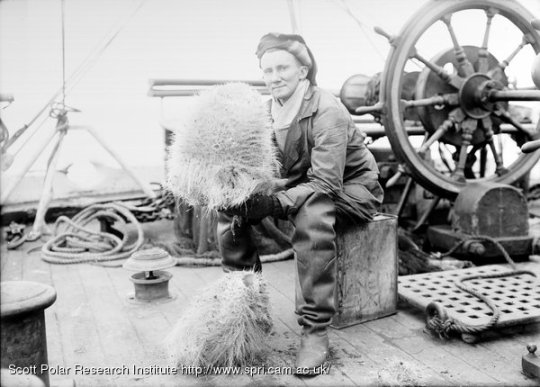
denis (also spelled dennis) gascoigne lillie was born in 1884, making him 26 when the terra nova set off for antarctica. he was trained in natural sciences at cambridge (although he didn't do too well on his exams) and was appointed as the ship's biologist—meaning he did not form part of the shore party in the hut in at cape evans, but remained on board the ship during the winter, studying antarctic marine biology including whales, plankton, and deep-sea creatures like sponges (like the one pictured above). his nickname "ooze" comes from his job as biologist—ooze refers to a specific kind of biological marine sediment that got pulled up in seabed dredges which lillie would then examine.
in silas's diary on the voyage south, he describes lillie:
Lilley—"Hercules'" or "Sequins" is rather a
dreamer and asserts he can remember his former existences in
this world. Much fun can be got from him if handled properly.
lillie was noted by other members of the expedition to be a bit of a crackpot, asserting that he was a persian and a roman in his past lives. and more than that, possibly:
Lillie had decided that he was not the marrying type, claiming that he had evolved beyond it. In later years Scott’s young Norwegian skiing expert Tryggve Gran recounted that as they crossed the Equator on the Terra Nova Lillie had revealed that he was a woman trapped in a man’s body. ‘When I see a naked man I blush,’ he allegedly said as the others sprawled shirtless on the deck in tropical sunshine, ‘I am split and I can’t help it. Luckily I understand myself and have the control to avoid doing anything wrong.’ Gran was a notoriously unreliable source, and it is hard to imagine anyone having the courage to say that under those circumstances; but perhaps Lillie did.
(from sara wheeler's cherry)
usually i would not recommend anyone trust anything that comes out of gran's mouth, but honestly i do buy this, because, well... vibes.
anyway, on the terra nova, lillie was notable for his talent at caricature, and several of his rather hilariously cruel drawings appeared (copied by wilson) in the south polar times, including this one of birdie:

while the shore party was in antarctica, lillie spent two winters in new zealand studying whales, fossils, and anthropology:
Lillie has been fossilizing & is off next month for 5 months whaling with the Norwegians. He is looking very well & very happy and is ‘a dear little chap’ to use Scott’s expression.
—pennell's diary, may 18 1911
after returning to england, taking the long way round on board the terra nova to continue his marine research, lillie took up residence at cambridge again, alongside deb, silas, priestley, and griff, to work up the scientific results from the expedition.
lillie also spent a lot of time with atch and pennell in 1913, frequently accompanying them to dine and see theater in london. he also drew (probably on board the ship) the caricature of them as the "antarctic lovebirds":

during the war, he was a conscientious objector—a "conchie," refusing to go to the front. it was an incredibly difficult position to maintain in the face of widespread societal opposition. he found solace in a continued and deepening relationship with cherry (who was also not at the front, though in his case for health reasons) as sara wheeler describes in her biography of cherry:
Currently working as a bacteriologist for the military, Lillie had been one of the few visitors at Lamer during the bad months in the middle of 1916. They became unusually intimate (‘I should love to see your chubby cheeks again’), and after one weekend Lillie scrawled with typical irreverence in his note of thanks that, ‘It was only my body which left you, for my ultimate Reality still walks behind your Bath chair and meditates about the many paths of your lovely garden. With love.’
and god i just need to copy these entire sections from the wheeler in here because they make me want to sob:
In September 1916 he had been transferred to the pathology lab of a military hospital in Bournemouth, which he loathed (‘no nice cliffs or sea birds, only sand banks and orange peel’), and was appalled to learn the next year that Cherry was poised to become engaged to Christine Davis (‘being unconventional and as near to nature as I can get, it seems all wrong to me that you should have to tie yourself up for the sake of Society’), but he strove, generally, to be optimistic, whereas Cherry was permanently resigned to his destiny. In August 1917 Lillie returned to Lamer for a week. Writing in advance with details of his train to Hatfield, he concluded that, ‘if a motor does not turn up the wings of joy will waft me those four-and-a-half miles bag included. So don’t worry.’ They had a wonderful time together. ‘I do hope,’ Lillie wrote when he was back in horrible Bournemouth, ‘your throat and the rest of you continues to get well and worthy of the sunny spirit which I see under the label ACG.'
though things seemed to be going as well as they could for lillie, shortly before the end of the war in early 1918, he suffered a nervous breakdown and landed in the notorious bethlem mental institution, known as bedlam. he was there for three years, and cherry was barred from visiting him.
he emerged for a short period of time in 1921, seemingly recovered, and took up lecturing in biology again at cambridge, but by the end of that year had relapsed and was institutionalized again.
frank debenham, writing to expedition agent j.j. kinsey in 1927 to solicit funding for SPRI, gave him an update:
Poor old Lillie is in less happy circumstances, the last I heard of him was that he was never likely to get out of Bedlam, a rather ghastly end up for poor old "Ooze's" brilliant promise.
lillie spent the rest of his life in institutions, and lived until the age of 78, dying in 1963. that was four years after the death of his friend cherry—who, despite constant attempts, was never allowed to visit him.
per UK law, lillie's medical records will be sealed until 2063, 100 years after his death, but a post on bethlem's official blog about lillie briefly notes that he was "depressed, delusional and suicidal."
the post also notes, importantly, that his breakdown had nothing whatsoever to do with his antarctic experiences:
The content of his medical notes suggests that the state of mind that brought him to hospital was entirely unrelated to his experiences of 1910-1913. Indeed, they report that “on the whole he felt better during this time”.
OK, let's end on a nice note. here's a picture of him having a nice time at silas's wedding (i think) with his best friends. RIP lillie, i hope your next life is going well somewhere out there right now 🥲💓
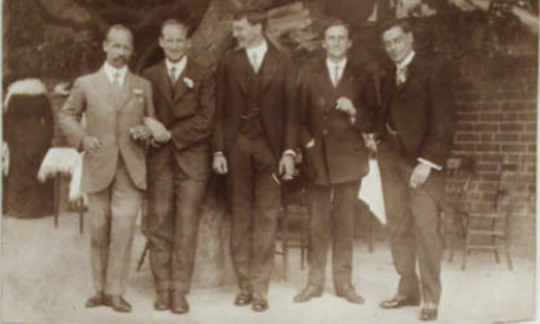
(also another good writeup on lillie with some lovely art can be found on @worstjourney's patreon here!)
81 notes
·
View notes
Text
Antarctic Food
Below you will find my account of eating at McMurdo, but PBS did a whole special on it which has more privileged access and, like, moving pictures and stuff. I highly recommend watching that if you're at all interested in the food question.
As other pleasures in life are restricted or eliminated, food gains significance beyond mere nutrition. When removed from the comforts and diversions of civilisation for months or years at a time, polar explorers had to pay particular attention to the culinary side of their enterprise. Scott learned this the hard way on the Discovery, when their cook was so bad he was sent home after the first year and others took over his job in shifts. Shackleton, on his second visit to Antarctica, brought all sorts of tinned delicacies, and left a lot of them behind in his hut at Cape Royds, which the Terra Nova men would raid on day trips from Cape Evans. Scott was much more careful with his choice of cook on his second expedition, and in his journal he continually praises Clissold's cooking – though Atkinson, writing for a publication he knew no one would read, says that Archer (the ship's cook, who filled in after Clissold was invalided home) was a far superior chef, and made the miserable second winter that much more bearable.
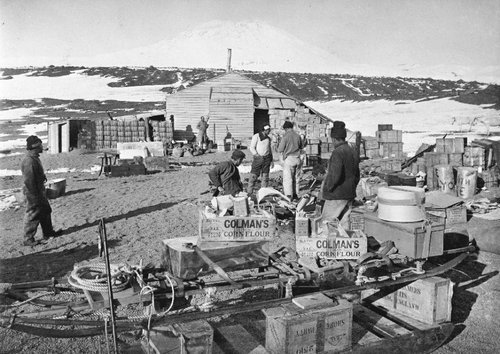
The expeditions of the early 20th Century brought down crates and crates of imperishables – tinned vegetables, powdered milk and eggs, and dry goods like flour, sugar, and tea. These were necessary, of course, but were ultimately supplemental to the core of their diet, which was the produce of Antarctica itself. In fact, in a letter laying out contingency plans if the Terra Nova Expedition were stranded in Antarctica, Scott says not to worry for their safety because the continent provides enough food to keep a party happily fed; they would only be wanting the comforts of a civilised menu. Mostly what the continent provided was seals, whose meat (especially livers) contained enough Vitamin C to stave off scurvy, but penguins and their eggs also regularly passed through the kitchen, and the contents of the marine biologist's net – once properly enumerated and dissected, of course – would often end up in the frying pan. The Notothenia fish was commonly eaten at breakfast, appreciated for its 'sweet' and 'nutty' flavour. Notothenia’s claim to fame is the sugar in its blood that acts as an antifreeze, so this is hardly a surprise.
Thanks to the Antarctic Treaty forbidding the killing of animals for consumption, modern Antarctic larders are not stocked with local wildlife, and as far as I know, no one down there now has tasted the sweetness of Notothenia. They do, however, have the advantage of modern transport and food storage, not to mention a century's worth of advances in the study of nutrition, so the diet of the present-day Antarctican is fresher, healthier, and much more diverse.
McMurdo Station's annual food supply arrives in one lump delivery, every January, on a big cargo ship from California. From the harbour where the Discovery berthed, it goes into climate-controlled storage, either to the dry goods store or to the freezer, which is a whole building off the cafeteria in the main station hub. A freezer, in Antarctica? Why, yes, because food safety regulations require frozen food to be kept at a constant temperature, and the only way to ensure that is to build an enormous manmade freezer in the land of ice and snow. In the summer, temperatures at McMurdo will wander around freezing, so this is entirely practical, but for much of the year, it's actually warmer inside the freezer than outside.
The modern Antarctic commissariat is not entirely divorced from its Edwardian predecessor, though – frozen vegetables taste fresher than tinned, and are more nutritious and palatable, but they are not fresh; powdered milk and powdered eggs are still the status quo. During the summer, perishable groceries – called 'freshies' – come down on the flights from New Zealand, if there is room after the passengers and equipment are loaded. After a month of flight cancellations, fresh apples and oranges are greeted with as much delight as they were on the arrival of relief ships in the Heroic Age, and the appearance of a salad bar in the Galley prompts general rejoicing.
The US Antarctic Program has its roots in the Navy, and McMurdo is still provisioned by one of the big firms that supplies the US military. Having had experience with industrial-scale American catering in California, I had moderate expectations of the quality of food at McMurdo, but it was surprisingly good. One might argue that the excitement of being there and the daily energy expenditure would be a good sauce for anything, and this may be true, but against this I would argue that dry air impedes one's ability to taste – that fact it was so flavourful at all is significant. People kept apologising for the food in the Galley and I kept telling them, earnestly, that it was better than the food in the Disney commissary. They didn't believe me, but I firmly attest this; I ate at Disney on my return journey and have confirmed it by direct comparison. I know they were working with roughly the same quality of ingredients, but the chefs at McMurdo reliably made things delightful to eat, which is more than I can say for the other place. Why this should be is anyone's guess ... Working as a Galley Rat is one of the few ways enthusiasts can get down to the Ice, so it's full of keen, intelligent, and curious cooks, and maybe that rubs off on the food. There are people who come back to tackle the unique challenges of Antarctic cuisine year after year, so maybe they're more experienced and invested in the job. My personal theory is that because they have to eat the food, too, of course they're invested in making it tasty – I suspect the folks behind the counter in LA have much better meals waiting for them when they get home.
Mealtimes follow a strict schedule:
5:30-7:30 Breakfast (many a time I missed the cutoff, woe)
11:00-13:00 Lunch
17:00 to 19:30 Dinner. There was always a portion of the cafeteria serving breakfast food at this time; this was reserved for the night shift workers, who got a reprise of the day shift's dinner for their lunch. If you really liked whatever was served for dinner, nothing could stop you coming around again for another go at midnight.
The one exception to this was Sunday, when a brunch would be served from 10 to 12. The service in the chapel started at 10 as well, and was very weak competition. Brunch was always excellent, and being the single day off, was often where one would meet up with people who were too busy during the week.
If you failed to make a mealtime for any reason, there was always something on offer. A fridge would be stocked with packaged leftovers, sandwiches, and other food-to-go – when I had a day out, I would eat breakfast and then grab my lunch from this fridge. On one occasion, dinner included fried okra (one of my faves, rarely had outside the States) and after stuffing myself with it, I nabbed two or three extra portions and cached them in my dorm room mini-fridge to enjoy later.
In a challenging environment, with a lot of people doing energy-intensive jobs, calories are important. There was only one rule regulating portions: Take what you want, but eat what you take. With a finite amount of food on hand, and delivery only once a year, food waste is anathema – if you need it, then eat it, but do not throw any away.
The menu seemed to originate with whatever presented itself in the enormous freezer, though perhaps in November and December it was dictated more by what remained in it, prior to the new shipment. We didn't suffer for want of variety, though: if anything, we benefited from a surfeit of prawns, including great bowls of them at Sunday brunch. I found myself wondering if the US military had a contract for most of the catch from the Gulf, and how much of their famously inflated budget went into that; I suspect, in reality, the kitchen just hit a seam of prawn in the recesses of the freezer and had to use it up. As a devotee of all shapes of sea bug, I was in seventh heaven, and did my level best to help McMurdo clear the surplus.
Once new food was defrosted and cooked up, it would cascade through various dishes down the week, as leftovers were repurposed to minimise waste. Usually this was successful, but sometimes they had to try a little harder ...

A variety of cuisines were offered, some of which were more successful than others. They seemed to reflect the makeup of the US military, for whom the rations would have been designed. The best dishes were the meat-and-potatoes variety (my minder said that if she were on Death Row, she'd ask for McMurdo Pot Roast for her last meal), Italian, Southern (see above re: okra), and what I assume was Tex Mex – the only misstep on the last count was an almost inedibly hot 'taco soup' which may have been more of a delivery vehicle for leftovers than an intentional dish. The only disappointments were anything attempting to be Asian, and the fish, which, due to the circumstances, was always overcooked. Provision was always made for vegetarians and even vegans, but I can't say I noticed many people adhering strictly to those diets. I suppose if the animals are already dead and in the freezer, there's little difference whether you eat them or not.
There was also, always, pizza. It was left in one of those tiered heated racks like you get at a buck-a-slice takeaway pizzeria, but this was no buck-a-slice pizza, this was McMurdo pizza, and McMurdo pizza is AMAZING. My brother-in-law's cousin went to super legit pizza school in Naples, and gets queues down the street wherever he opens a pizzeria. He makes the best pizza I have ever had anywhere; McMurdo’s wasn't quite as good as his, but it was pretty darn close. It's a testament to how good the rest of the food was that I didn't just have pizza for every meal. The pizza kitchen runs 24 hours a day, and takes orders for pickup from all across the base. If you're flying out to a field camp, it's good manners to take their pizza order and deliver it to them hot and fresh. For all the advances in food technology since the Heroic Age, surely the greatest has to be the McMurdo Pizza.
We were reminded constantly how important hydration was, and the Galley offered a range of liquids at all hours. To my surprise, what looked like a soda fountain offered not pop but fruit juice – grapefruit, orange, cranberry, and apple, though one or more often ran out before the end of breakfast. There were enormous urns of extremely weak coffee – a provision, I supposed, for its diuretic effects – though with 10-hour workdays and very early starts, a little more oomph would have gone a long way. Experienced hands, and those of discerning tastes, brought their own coffee or sourced it somehow from the stores. The kitchenette in the Crary library was full of people's personal coffee-making supplies as they sought a more effective brew.
I had been warned that if I liked tea, I should bring my own; this was a sound warning, as the black tea on offer looked and smelled as though it had been on a shelf for about a decade. What I had not been warned about was that the only 'milk' on hand for one's coffee or tea was, in most places, 'coffee whitener', a ubiquitous Americanism which I'd completely forgotten about (or supressed?) since moving away. For those who've not had the privilege of its acquaintance, this is a blend of margarine, sugar, synthetic vanilla, and titanium dioxide, rendered into a powder by some unknown chemical process and packaged up to pass for milk. (I think it might be illegal in Europe. I've certainly not seen it around.) The Galley had the base's only dispenser of actual mammalian lactation – reconstituted from powdered, of course. If I were to go again, I would bring a small bottle to fill there with 'real' milk, which I could take away for tea purposes elsewhere. There were boxes of UHT milk available for purchase in the shop, and had I been staying longer I might have invested in some, but for just a splash per cuppa, it hardly seemed worthwhile.
The undisputed star of the Galley was the soft serve ice cream dispenser, named Frosty Boy (or Boi), an ancient beast that was such an institution that it was rumoured the USAP had bought another one from a junkyard just for parts. The Thing to Do was, instead of putting milk or coffee whitener in your coffee, to use a dollop of Frosty Boy instead – I'm not sure which end of the dairy/non-dairy spectrum his product was nearest, but it did go well in the coffee, such as it was. More often than not while I was there, Frosty Boy exuded only a watery splutter rather than creamy delight – even when he was working, the product was rather gritty – but I was assured he was just going through a phase, and would be right again soon. I got the impression that if anyone tried replacing the machine with something more reliable, or which produced something more resembling ice cream, there'd be a protest. We shall see if Frosty Boy survives the station revamp, as the NSF seems keen to scrub out any vestiges of character ...
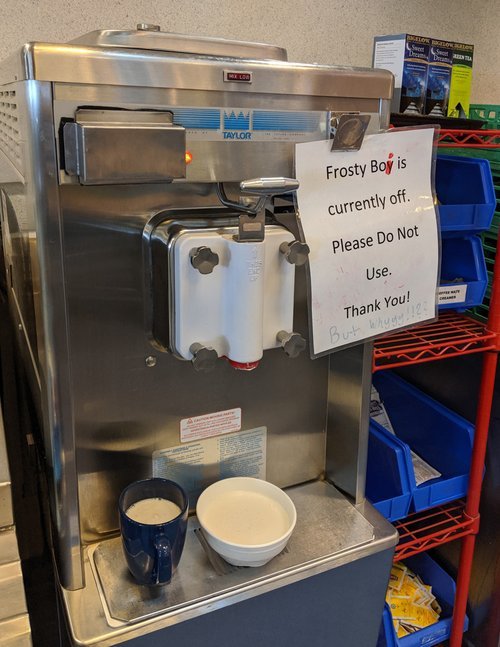
I have brought two things back from the McMurdo Galley, and they're things that go right back to the beginning: powdered milk and powdered egg. Even when I'm near a shop with both in fresh form, it's convenient to have the powdered on hand for recipes. I really only use milk to splash in my tea and coffee, so don't keep a large amount in my fridge, but recipes often call for far more than I have – so instead of making a trip for the extra, I can just mix it up on demand. I've also taken on the Perpetual Yoghurt: McMurdo makes its own yoghurt from its vast reserves of powdered milk, using a bit of the last batch to inoculate the next, and it turns out this is perfectly doable at home, too. Eggs eaten as eggs are better fresh, of course, but when providing structure in a recipe, no one's going to notice if they've been reconstituted, and then I can save my 'real' eggs for when they'll be appreciated. It's a good system, and economical, too. Alas, the pizza isn't as easy to replicate at home ...
For more information on McMurdo food –
The Antarctic Sun newsletter put out this podcast: https://antarcticsun.usap.gov/features/4329/
I didn't mention how good the desserts were; I was lucky enough to share my time at McMurdo with Rose McAdoo, who was featured in this story on NPR: https://text.npr.org/779463164
160 notes
·
View notes
Text
just found this virtual tour some guy did of the cape evans hut. ough.
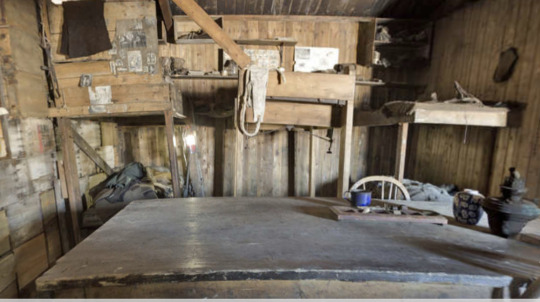
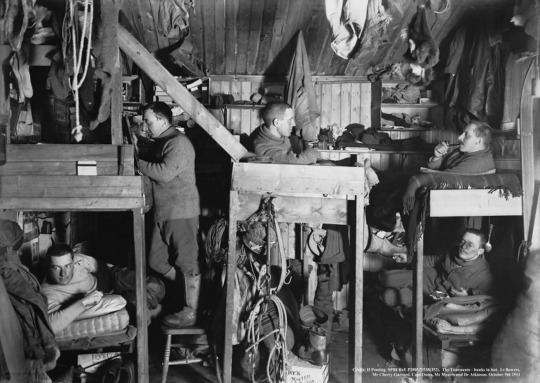
#this website has other virtual tours but i thought i’d show you guys this one bc it’s making me a little bit insane#also it’s a window into how haphazard the whole hut was. i may have exposed concrete floor in a decent chunk of my apartment#but at least my walls aren’t made of crates and i have a door#(circus music starts)#terra nova#🗺️
14 notes
·
View notes
Text
One day, I'm going to have to write some polar boy fanfic. But what and how and stuff? It's been brewing for decades, since TLPoE, let's face it. I mean, look at my username.
And there's all this comment and art on here and photos I've never seen before ... and it's under my skin as much as it was when I was 14 and imagined I travelled back in time and lived in the Cape Evans hut with them all in 1911 (and I was older in my head obvs) and they all fell in love with me (well, Deb and Atch and Nelson and Day and Cherry and sometimes even Con) but my heart only belonged to the Soldier cos he was beautiful but a total fucking enigma (but also not).
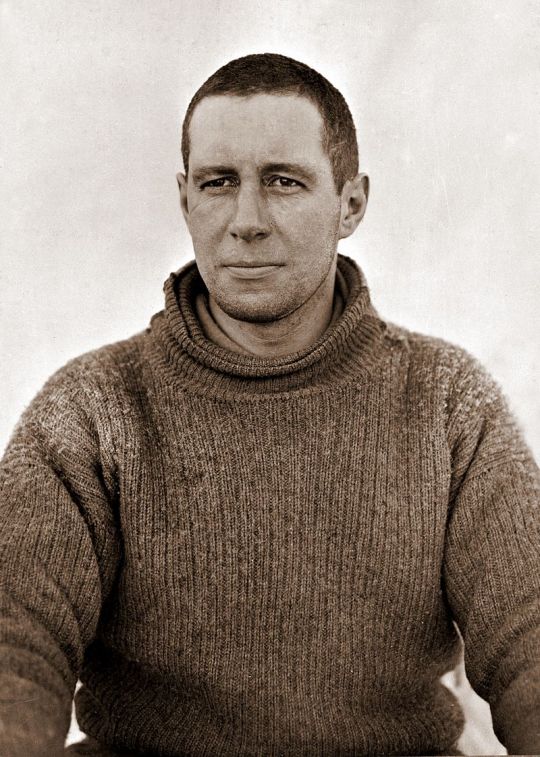
#antarctic exploration#scott of the antarctic#captain oates#lawrence oates#captain scott#polar boys#frank debenham#bernard day#edward nelson#apsley cherry garrard#fanfic#Edward Atkinson
2 notes
·
View notes
Text
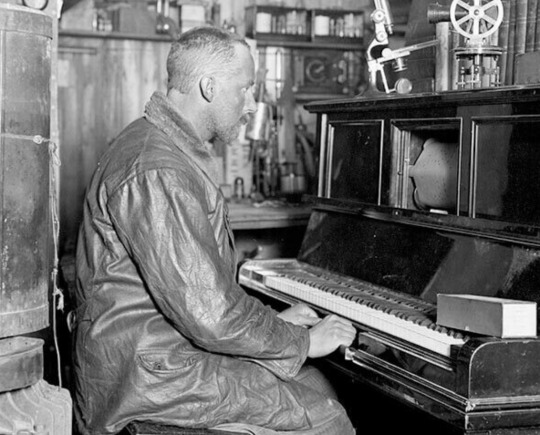
Cecil Meares at the pianola in the hut at Cape Evans, 1911
6 notes
·
View notes
Photo

Did you superheroes wear capes; some carry Restaurant Redemption Codes. With discounts at 70,000+ locations, say goodbye to full-price meals at your favorite spots like IHOP and Baskin Robins.?? #FoodieFacts #SuperSavings. #Red Lobster # #Boston Market # #Denny?s # #Bob Evans # #KFC # #McDonald?s # #Subway # #Baskin Robins # #Burger King # #Pizza Hut # #IHOP # #Starbucks # #Chili?s
0 notes
Photo
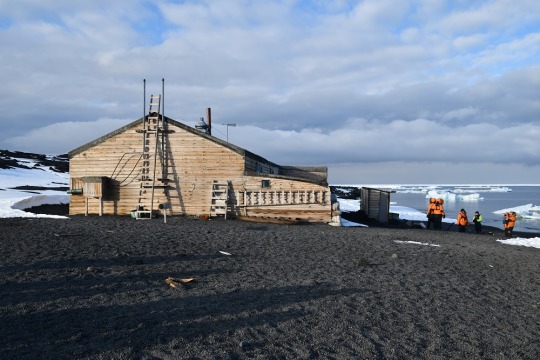
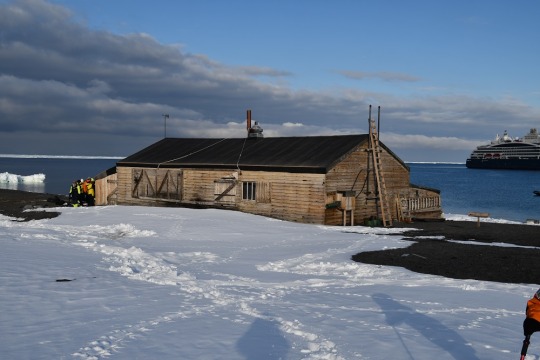
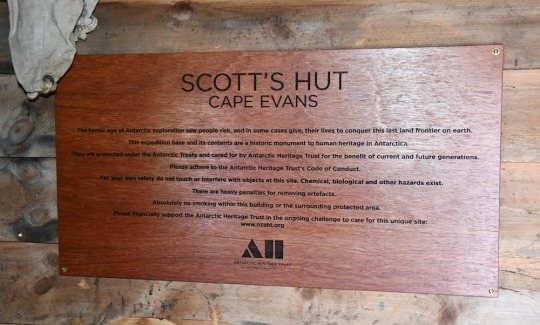
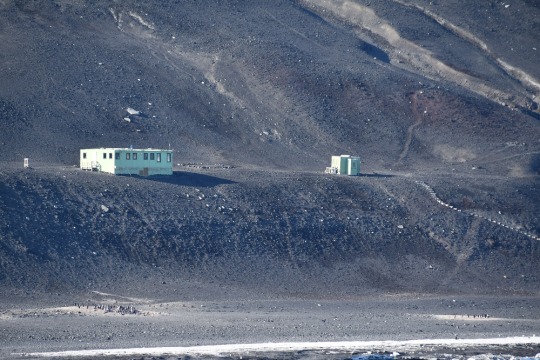

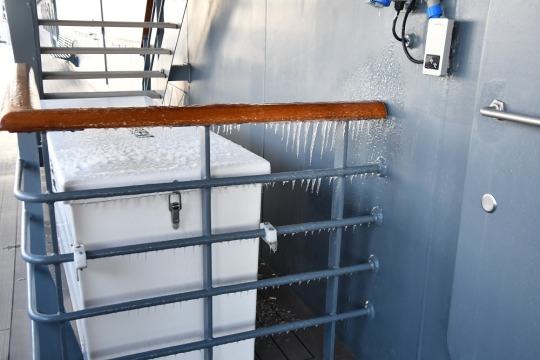
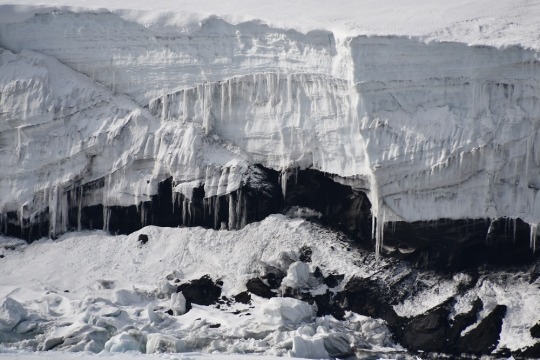
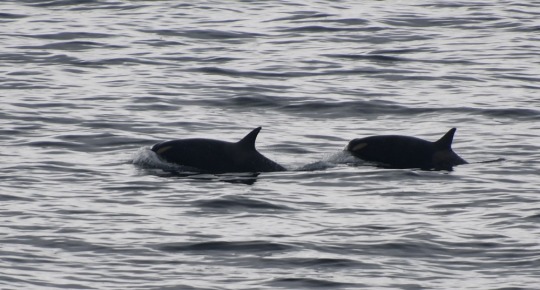

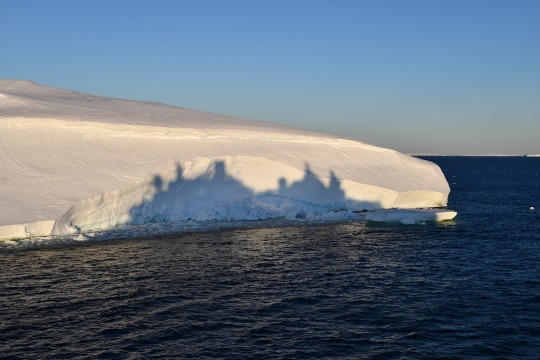
A mixture of photos. Scott’s Hut at Cape Evans and the plaque inside the door. The hut at Cape Royds that was out of bounds. A few icicles on board and some more on land. Some more orcas and the shadow of the ship passing an iceberg.
0 notes
Video
youtube
Captain Scott's Hut | Frozen in Time | Cape Evans | Ross Island | Antarctica | HD
#captain scotts hut#robert falcon scott#american ghost towns#ross island#cape evans#antarctica#frozen in time#abandoned hut#terra nova expedition#scotts hut#british antarctic expedition
3 notes
·
View notes
Link
Antartica – 8 best places to visit No place on Earth compares to this vast white wilderness of elemental forces: snow, ice, water, rock. Antarctica is simply stunning. Share Antarctica’s surreal remoteness, extreme cold, enormous ice shelves and mountain ranges, and myriad exotic life forms invariably challenge you to embrace life fully. Ice and weather, not clocks and calendars, determine the itinerary and the timetable of all travel here. This continent is home to some of the world’s most extraordinary species. Some migrate far and wide, like the enormous whales, others remain close to the continent, like the Weddell seal and the emperor penguin. Millions of seabirds skim the Southern Ocean, the world’s most abundant ocean – species such as far-flung albatrosses and petrels circle these waters. Antarctica possesses an unnamable quality, which is simply the indescribable feeling of being a small speck in a vast, harshly beautiful land. Antartica is a land where striated ice towers float among geometric pancake ice, literally untouched mountains rear from marine mist, and wildlife lives, year in and year out, to its own rhythms, quite apart from human concerns. Amundsen-Scott South Pole Station: First reached just 100 years ago by the valiant explorer Roald Amundsen during the Heroic Age of Antarctic exploration, the South Pole still embodies myth, hardship and glory. Today it is topped by a new high-tech station surrounded by cutting-edge astrophysical observation equipment (including a neutrino detector array buried approximately 1.9 km below the ice) Cruising the Lemaire Channel: The sheer-sided Lemaire Channel is a perennial favorite for photography buffs and naturalists. Under pale-pink skies, glaciers tumble slow-motion to the sea from the mountains overhead. Your Zodiac glides past a floe topped by basking Weddell seals, another crowded by a noisy group of gentoo penguins. Nearby, an enormous female leopard seal sleeps off a recent meal. Cape Evans: Reaching Ross Island’s Cape Evans isn’t easy – but then again, it never was. Dog skeletons bleach on the sand in the Antarctic sun, chiding memento mori of Captain Robert Scott’s death march from the Pole. Inside Scott’s hut from that ill-fated Terra Nova expedition a collection of sledging pennants, rustling pony harnesses and a sighing wind evoke the doomed men who left here with high hopes of reaching the pole. Shackleton’s Hut: Step inside Ernest Shackleton’s Nimrod expedition hut at Cape Royds on Ross Island and enter an eerily preserved world from a century ago. Amazingly intact despite 100 years of blasting Antarctic storms, the wooden house is surprisingly homey. Colored glass medicine bottles line shelves, a fur sleeping bag rests on one of the bunks and tins of food with unappetizing names (boiled mutton, lunch tongue, pea powder) are stacked on the floor, awaiting diners who will never return. Adélie penguins fill the cape now, breeding in summer Paradise Harbor: The pragmatic whalers who worked in the waters of the Antarctic Peninsula at the beginning of the 20th century were hardly sentimental. Yet they named this harbor Paradise, obviously quite taken with the stunning icebergs and reflections of the surrounding mountains. Gentoos and shags call the area home. A climb up the hill here offers magnificent glacier views – if you’re lucky you might see one calving into the Southern Ocean. Grytviken, South Georgia: A tall granite headstone marking the last resting place of British explorer Ernest Shackleton, known to his loyal men as ‘the Boss,’ stands at the rear of the whalers’ cemetery at Grytviken. This old whaling station is still strewn with evidence of its past industry, and its museum gives insight into whaling life, and into South Georgia’s history and wildlife. Meanwhile, seals wriggle outside the station’s white-clapboard whalers’ church. Deception Island: Deceptive in more ways than one, with its secret harbor, slopes of ash-covered snow and hidden chinstrap penguin rookery at Baily Head, Deception Island offers the rare opportunity to sail inside a 8 volcano. Now classified as having ‘a significant volcanic risk,’ Deception remains a favorite for the industrial archaeology of its abandoned whaling station, half-destroyed by an eruption-induced mudflow and flood. Some will stop for a quick dip in the island’s heated geothermal currents. Antarctic Museum: Each year in Antartica, tens of thousands of visitors flock to Britain’s beautifully restored Bransfield House, the main building of Base A, built at Port Lockroy during WWII. Not only does it offer the chance to spend up big at the well-stocked souvenir shop and to mail postcards at the busy post office, the museum’s old wooden skis, clandestine 1944 radio transmitter and wind-up HMV gramophone are evocative artifacts of the explorers who once lived for years at this wilderness outpost. Find destinations with accomodation around the world
1 note
·
View note
Photo
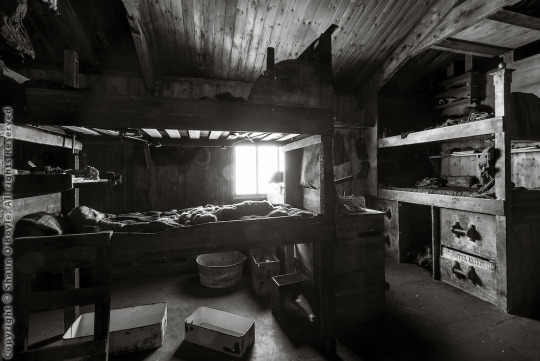
Wright and Simpson's bunks - Scott’s Hut at Cape Evans
Shaun O’Boyle
oboylephoto
3 notes
·
View notes
Text
The Millennials' Polar Expedition
A year ago today (23 Nov 2022), I launched Worst Journey Vol.1 at the Scott Polar Research Institute. This is the text of the speech I gave to the lovely people who turned up to celebrate.
As many of you know, my interest in the Terra Nova Expedition was sparked by Radio 4’s dramatisation of The Worst Journey in the World, now 14 years ago. The story is an incredible story, and it got its claws into me, but what kept me coming back again and again were the people. I couldn’t believe anyone so wonderful had ever really existed. So when I finally succumbed to obsession and started reading all the books, it was the expedition members’ own words which I most cherished. These were not always easy to come by, though, so plenty of popular histories were consumed as well. Reading both in tandem, it soon became clear that, while there were some good books out there, there was a lot of sloppy research in the polar echo chamber as well.
I also discovered that no adaptation had attempted to get across the full scope of the expedition. There has never been a full and fair dramatic retelling, all having been limited by time, budget, or ideology from telling the whole story truthfully. I was determined that my adaptation would be both complete and accurate, and be as accountable as possible to those precious primary documents and the people who wrote them.
So the years of research began. I moved to Cambridge to be able to drop in at SPRI and make the most of the archives. Getting to Antarctica seemed impossible, but I went to New Zealand to get at least that much right, and on the way back stayed with relatives in Alberta, the most Antarctic place I could realistically visit. I gathered reference for objects wherever I could. Because Vol.1 takes place mainly on the Terra Nova, which is now a patch of sludge on the seabed off Greenland, I cobbled together a Franken-Nova in my mind, between the Discovery up in Dundee and the Star of India in San Diego. I spent a week on a Jubilee Sailing Trust ship in order to depict tall-ship sailing correctly. I’m sure I’ve still got loads of things wrong, but I did all I could, to get as much as I could, right.
But still, everyone I met who had been to Antarctica said, “you can’t understand Antarctica until you’ve been there, and you can’t tell the story without understanding Antarctica; you have to go.” So I applied to the USAP’s Antarctic Artists and Writers Program, with faint hope, as they do “Ahrt” and I draw cartoons. But I must have blagged a good grant proposal, because a year after applying, I was stepping out of a C-17 onto the Ross Ice Shelf. The whole trip would have been worth it just to stand there, turn in a circle, and see how all the familiar photographs fit together. But the USAP’s generosity didn’t stop there, and in the next month I saw Hut Point, Arrival Heights, the Beardmore Glacier (including the moraine on which the Polar Party stopped to “geologise”), and Cape Crozier, and made three visits to the Cape Evans hut. Three! On top of the visual reference I got priceless qualitative data. The hardness of the sound. The surprising warmth of the sun. The sugary texture of the snow. The keen edge on a slight breeze. The way your fingertips and toes can start to go when the rest of you is perfectly warm. The SHEER INSANITY of Cape Crozier. The veterans were right – I couldn’t have drawn it without having been there, but now I have, and can, and I am more grateful than I can ever adequately express. With all these resources laid so copiously at my feet, all I had to do was sit down and draw the darn thing. Luckily I have some very sound training to back me up on that.
Now, this is all very well for the how of making the book, and, I hope, interesting enough. But why? Why am I putting so much effort into telling this story, and why now?
Well, it means a lot to me personally. To begin to understand why, you need to know that I grew up in the 80s and 90s, at the height of individualist, goal-oriented, success-driven, dog-eat-dog, devil-take-the-hindmost neoliberalism. It was just assumed that humans, when you get right down to it, were basically self-interested jerks, and I saw plenty of them around so I had no reason to question this assumption. The idea was that if you did everything right, and worked really hard, you could retire at 45 to a yacht in the Bahamas, and if you didn’t retire to a yacht, well, you just hadn’t tried hard enough. Character, in the sense of rigorous personal virtue, was for schmucks. What mattered was success. Even as my politics evolved, I still took it as a given that this was how the world worked, and that was how people generally were – after all, there was no lack of corroborating evidence. So: I worked really hard. I single-mindedly pursued my self-interest. I made sacrifices, and put in the time, and fought my way into my dream job and all the success I could have asked for.
And then I met the Terra Nova guys.
What struck me most about them was that even when everything was going wrong, when their expectations were shattered and they had to face the cruellest reality, they were still kind. Not backbiting, recriminating, blame-throwing, defensive, or mean, as one would expect – they were lovely to each other, patient, supportive, self-sacrificing; in fact the worse things got, the better they were. They still treated each other as friends even when it wasn’t in their self-interest, was even contrary to their self-interest. I didn’t know people could be like that. But there they were, in plain writing, being thoroughly, bafflingly, decent. Not just the Polar Party – everyone had to face their own brutal realities at some point, and they all did so with a grace I never thought possible.

It presented a very important question:
When everything goes belly-up, and you’re facing the worst, what sort of person will you be?
Or perhaps more acutely: What sort of person would you rather be with?
It was so contrary to the world I lived in, to the reality I knew – it was a peek into an alternate dimension, populated entirely with lovely, lovely people, who really, genuinely believed that “it’s not whether you win or lose, but how you play the game,” and behaved accordingly. It couldn’t be real. There had to be a deeper, unpleasant truth: that was how the world worked, after all. I kept digging, expecting to hit bottom at some point, but I only found more gold, all the way down. How could I not spend my life on this?
Mythology exists to pass on a culture’s values, moral code, and survival information – how to face challenges and prevail. Scott’s story entered the British mythology, and had staying power, because it exemplified those things so profoundly for the culture that created and received it. But the culture changed, and there were new values; Scott’s legacy was first inverted and then cast aside. The new culture needed a new epic hero. You’d think it would be Amundsen, the epitome of ruthless success, but “Make Plan – Execute Plan – Go Home” has no mythic value, so he didn’t stick. The hero needed challenges, he needed setbacks, and he needed to win, on our terms.
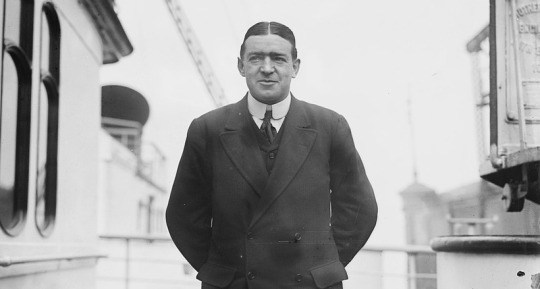
Shackleton! Shackleton was a winner! Shackleton told us what we knew to be true and wanted to hear at epic volume: that if you want something badly enough, and try really hard, you will succeed! (Especially if you can control the narrative.) Scott, on the other hand, tells us that if you want something badly enough, and try really hard . . . you may nevertheless die horribly in the snow. Nobody wants to hear that! What a downer! I think it’s no coincidence that Shackleton exploded into popular culture in the late 90s and has dominated it ever since: he is the mythic hero of the zeitgeist. I am always being asked if I’ll be doing Shackleton next. He has six graphic novels already! That is plenty! But people still want to tell and be told his story, because it’s a heroic myth that validates our worldview.
That’s why I am so determined to tell the Scott story, because Scott is who we don’t realise we need right now – and Wilson, and Bowers, and Cherry, and Atch, and all the rest. The Terra Nova Expedition is the Millennials’ polar expedition. We’ve worked really hard, we’ve done everything we were supposed to, we made what appeared to be the right decisions at the time, and we’re still losing. Nothing in the mythology we’ve been fed has prepared us for this. No amount of positive attitude is going to change it. We have all the aphorisms in the world, but what we need is an example of how to behave when the chips are down, when the Boss is not sailing into the tempest to rescue us, when the Yelcho is not on the horizon. When circumstances are beyond your power to change, how do you make the best of your bad situation? What does that look like? Even if you can’t fix anything, how do you make it better for the people around you – or at the very least, not worse? Scott tells us: you can be patient, supportive, and humble; see who needs help and offer it; be realistic but don’t give in to despair; and if you’re up against a wall with no hope of rescue, go out in a blaze of kindness. We learn by imitation: it’s easy to say these things, but to see them in action, in much harder circumstances than we will ever face, is a far greater help. And to see them exemplified by real, flawed, complicated people like us is better still; they are not fairy-tale ideals, they are achievable. Real people achieved them.
My upbringing in the 80s milieu of selfishness, which set me up to receive the Scott story so gratefully, is hardly unique. There are millions of us who are hungry for a counter-narrative. My generation is desperate for demonstrations of caring, whether it’s activism or social justice or government policies that don’t abandon the vulnerable. We’ve seen selfishness poison the world, and we want an alternative. The time for competition is past; we must cooperate or perish, but we don’t know how to do it because our mythology is founded on competition. The Scott story, if told properly, explodes the Just World Fallacy, and liberates us from the lie that has ruled our lives: that you make your own luck. What happens, happens: what matters is how you respond to it. My obsession with accuracy is in part to honour the men, and in part because Cherry was the ultimate stickler and he’d give me a hard time if I didn’t, but also because, if I’m telling the story to a new generation, I’m damn well going to make sure we get that much RIGHT. It’s been really interesting to see, online, how my generation and the next have glommed onto polar exploration narratives, not as thrilling feats of derring-do, but as emotional explorations of found family and cooperative resilience. We love them because they love each other, and loving each other helps get them through, and we want – we need – to see how that’s done. It’s time to give them the Terra Nova story, and to tell it fully, fairly, and honestly, in all its complexity, because that is how their example is most useful to us. Not as gods, and not as fools, but as real human beings who were excellent to each other in the face of disaster. I only hope that I, a latecomer to their ways, can do them justice.
#scott expedition#terra nova expedition#the worst journey in the world#captain scott#polar party#robert falcon scott#birdie bowers#edward adrian wilson#bill wilson#character#millennials#polar exploration#heroic age#adventure#sociology#neoliberalism
193 notes
·
View notes
Note
I know nothing about polar exploration! Or Shackleton! But you seem excited about it!
Have a favourite fact you'd like to share?!?
well my two favorite facts have already been shared which are the cautionary tale of the toxic polar polycule and the story of the antarctic lovebirds !!!
but here is a contender for #3... the tale of jessamine.
let's start with our homies Deb (left) and Griff (right), aka Frank Debenham and T. Griffith Taylor, the geologists of terra nova's cape evans shore party:

they would both later go onto impressive careers in academia, start families, basically be well-liked hard-working guys (also participants in 20th century imperialism but let's take that as given based on our starting point of this expedition lol)
BUT we are meeting them here, in antarctica, aged 27 and 30, "Early Career Researchers" as we might call them now. trying to keep busy with SCIENCE during the long antarctic winter night of 1911!!!!!
these guys go way back btw. Deb was born and raised in Australia and and Griff moved to Australia when he was a kid, and they both attended the fancy-schmancy King's School near Sydney, the Australian equivalent of british public school (e.g. Eton). according to griff they were family friends at that time although they would have been a few years apart at school.
later around 1908 they both studied at the University of Sydney under leading geologist Sir Edgeworth David, who had been on Shackleton's Nimrod expedition and reached the South Magnetic Pole with Mawson. They both ended up being hired onto Scott's expedition through university connections, Deb via Professor David and Griff through a scholarship to Cambridge where he met Wilson.
okay. backstory established. now one thing you need to know about Griff is that he was a total freak. like Racovitza, he was a Poster before there were online platforms to Post on. if you had that kind of brain back then, and no access to adderall, you had to just sit around inventing new kinds of science instead of deep-frying spongebob screencaps. he was a consummate edwardian memelord who would read a novel per day and still have time to write 20 pages of diary in which he would floridly record the silliest things that happened since the morning, the various quirks and quotes of expedition members, and then complain about captain scott in shorthand.
to say nothing of his passion for CREATIVE WRITING! vitally, Griff was one of the main contributors to the Cape Evans hut magazine, the South Polar Times edited by Apsley Cherry-Garrard. there were 3 issues of this during the winter of 1911 and 1 issue during the winter of 1912, the latter of which included much material written/submitted during 1911 before the polar party met with tragedy.
Griff was a versatile writer, and his pieces (which would sometimes cumulatively make up nearly half an issue of the SPT by page count) ran the gamut from expository nonfiction to speculative poetry to comedic epistolary to magazine pastiche. he had certain motifs that he frequently returned to—none as compelling, in my opinion, as that of Jessamine. or Jasmine, or Jessie, or Jessica, as the case may be...
it all began, according to Griff's diary, early in the austral winter of 1911, when Deb was "christened Jasmine by Titus [Oates]."
where this nickname came from is unclear—many of the men had picked up female nicknames on the voyage down (see "Jane" Atkinson, "Marie" Nelson, "Penelope" Pennell) but Deb had not been on the voyage down because he had gotten picked up in Australia, so this may have been a belated attempt to correct that omission. Griff wrote in his book about the expedition, "We were short of female society—which lack also accounts for Jessie Debenham as an alternative to Deb."
in any case, the name clearly caught on: on midwinter day, a little under two months after the nickname's debut, Griff recorded that during the gift exchange after dinner "Every second present or so was a necklace or earrings for Miss Jessie Debenham."

(deb and titus at midwinter dinner)
THIS GOT REALLY LONG SO CLICK READ MORE IF YOU ARE INTERESTED!!
in the second SPT issue of 1911, Griff's 17-page narrative "The Bipes" describes the inhabitants of the Cape Evans hut from the perspective of a rabbit who lives in the stables. you can read the whole thing here and please do!!! (you'll need a VPN outside the US) BUT here is the relevant bit dealing with Deb:
U. PULCHERRIMA. This Bipe inhabits a strongly defended Bungkh in the Ubdug burrow. It is supported by mighty baulks of timber and can only be reached by means of a dangerous ladder. The Bungkh is supplied with heavy hammers, piles of stones and other offensive weapons. These precautions are, I believe, necessary in the Bipe courtship, for she is often called upon to repel members of other burrows who approach her balcony with blandishments. Her time is chiefly occupied with a primitive quern or handmill, and at this she grinds for long hours every day.
I judge that this merely satisfies some primitive habit, for no flour seems to be produced. But it is pleasant to see how strong is the feminine instinct.
the species name "Pulcherrima" is also the species name of the pointsetta flower, and can be translated to "beautiful woman" (i think??)
here's the illustration produced by Bill Wilson (based on Griff's sketch) to accompany the above - yes that's a portrait of Griff in her bunk and Birdie below attempting to woo her:

it must be noted that Meares, nicknamed "Mother," also gets cast in a female role in the Bipes piece, but does not receive the privilege of being drawn in a skirt, rip.
anyway, the next issue of the SPT, vol 3 issue III, is the last one to be produced before the end of winter. Griff decided to one-up himself and write a piece in which Jessamine takes center stage. The Ladies Letter is a pitch-perfect parody of the "Ladies Column" sections that appeared in many periodicals of the era—full of french fashion terms and simpering style suggestions. Griff brilliantly adapts the format for a pastiche on the subject of Antarctic fashion; not free, naturally, from general whiffs of period-typical misogyny, but as those being mocked in specific are fellow expedition members and not any actual women i forgive him.
written in the form of a letter from Jessamine to her absent friend Cynthia (whose identity i'm unsure of BUT i'm tempted to say is supposed to be Priestley, away at Cape Adare), the piece again features multiple expedition members in female roles, including Silas as "American" Sally Wright, Cherry as "Madame Chérie - that dear delightful person - who builds her beautiful creations on strictly scientific principles of hygiene and aesthetics" and Birdie as Madame Berdé, who "finds that for well developed figures it is most distinctive to use a cross-gartering well above the ankle. She herself is naturally a consistent exponent of this latter fashion."
and then of course there is Jessamine's star turn. she is wearing the newest fashion, "a modification of last year's 'tube skirt' [which] even more closely swathes the lower limbs, and it is necessary that the wearer should be rolled along by her maid."
Jessamine reveals that she is planning to induce Titus Oates to bring her a proposal of marriage through the clever use of themed charms on her chatelaine.
All the smartest girls have wreathed chains of mascots around the skirt, and a pretty idea, which I commend to you, is to have silver model made of those articles which interest THE ONLY MAN WHO COUNTS.
Breathe this to no one! But Mappin & Webb are making me such a choice set. The cutest little pony; a horse snowshoe (this is very lucky); a dead rabbit; a popgun; and a silver blazon PER MARE PER TERRAM PRO TITO; this will be attached to my 'tube', and then I really do expect to bring him to a proposal.
this scenario was illustrated hilariously by Bill, complete with Jessamine being rolled along, and Titus ignoring her as could be expected, in favor of a pony (Christopher?):
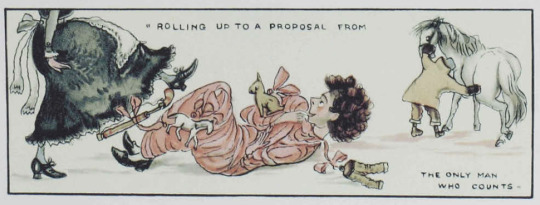
now, Deb is on record saying that Titus was his best friend on the expedition, but it may well be a classic case of "you are not your best friend's best friend," because per other accounts Oates was much closer to Meares and Atch than he was to Deb. that's just an observation to add a little flavor to Jessamine's desperate pursuit as portrayed here...
and not to look a gift horse (ha) in the mouth, but i do feel that Bill's illustrations don't quiiiiiite do the genderfuckery of Griff's text justice—Jessamine describes herself as wearing a frock inspired by the aurora, but Bill instead draws Deb in normal sledging gear plus some non-dress-shaped colorful streamers. a missed opportunity...

also, lest you think that Griff was the only one partaking in the Jessamine joke in the SPT, there is also a sneaky reference in the anonymous feature "My Favorite Book":

(J-SS-- [JESSIE]: "Not like other girls")
BUT WAIT. THERE'S EVEN MORE.
viewing the handwritten drafts of the SPT held at the SPRI (because all of this is going to be an actual academic paper someday hopefully lol), i learned that there were a fair handful of references omitted from the final version, presumably thanks to Cherry's editorial oversight.
one "answer to correspondents" written by "Marie" Nelson went as follows:
Jessica:
A single lady cannot be too careful about the respectability of her lodgings or the character of her companions.
(referencing Deb bunking with Griff and Gran, two of the more annoying/messy people in the hut)
and an unused entry in "Songs And Their Singers" by Teddy Evans was:
Oh What’s Womans Duty - Jasmin
lastly, and most importantly, the drafts contained the one instance i could find of deb firing back about this whole thing.
vol IV of the SPT consisted of one issue released during winter 1912, when a lot of people had gone home (including Griff), and everyone left behind knew the polar party was dead and they'd have to go look for their bodies in the spring. it was not a fun time. vol IV contained a lot of material written the previous year but not included, since for obvious reasons folks weren't really up to being silly. one of those pieces was "A Day's Doings, Told By Our Diarist," written during winter 1911 by Deb as a parody of Griff. it's pretty funny in published form (p. 72 of this pdf)—Deb is on-point mocking Griff's dislike of eating ("Breakfast is an unintellectual meal, so gave it a miss. Better a bit more bunk than a bite more breakfast.") and his never-ending theorizing ("Thought out a new theory as to the origin of debris cones: yesterday’s wasn’t good enough").
however, the draft is exponentially more hilarious. Cherry, damn him, cut the absolute BEST BIT:
Made a genre sketch of Jasmine brushing her (his) hair – it’s a fool nickname anyways, mixes up the genders.
knowing Deb—quiet, patient, chronically non-confrontational—that's about as explicit as he was willing to get, as far as revealing how he felt about the nickname. writing Griff realizing that it's a bit silly, he reveals to some degree his own discomfort. now, was it a "protest too much" situation or had he genuinely gotten fed up with being the Designated Girl Of The Hut? we shall never know!!!!!!!!
however the draft of the piece ends thusly: "[I] got paralysed at chess by the wily Jasmine, it’s a mud game, if ever there was one. Hinc illae lacrimae!"
so despite all the aspersions cast on her honor, and the failure of Titus Oates to accept her proposal, Jessie still triumphs in the end :)))
135 notes
·
View notes
Text
Scene 3: Int. Cape Evans, Aft Cabins
As usual, this is best viewed on the original blog: http://twirlynoodle.com/blog – Barring that, wait a bit and the images will eventually turn up here. I wish I knew what was happening. Anyway, enjoy . . .
We continue our tour of the Cape Evans hut in the aft starboard corner. For the map of the hut and previous stops, please start with the Men’s Quarters and progress to the Tenements.
Coming out of the Tenements, we proceed down towards the end of the wardroom and find ourselves looking into a corner that is almost, but not quite, its own little room. This is where Captain Scott’s bunk was, as well as that of Teddy Evans, technically his second-in-command, and Dr Wilson, who everyone else considered to be his second-in-command. We will look at Scott’s cubicle first.

There is another historic photo here, of the man himself in his domain.

I have a high-res version of this and it shows the place as I need to draw it, so I deliberately didn’t take any similar shots when I was there, as its modern state is rather denuded. It has also been photographed extensively by every visiting photographer for the last twenty years, so if I really need to find reference for the modern space I can easily find it on Google, as can you. However, there were some small details that I hadn’t seen before and which gave a tangible connection to overlooked everyday life in the past.
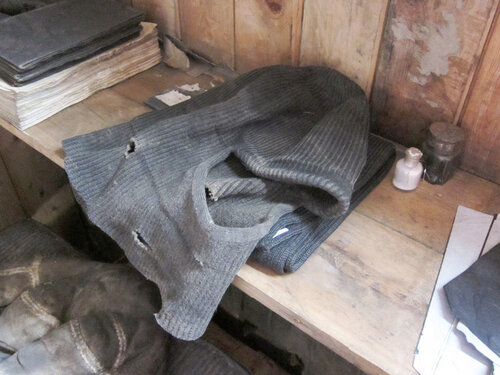
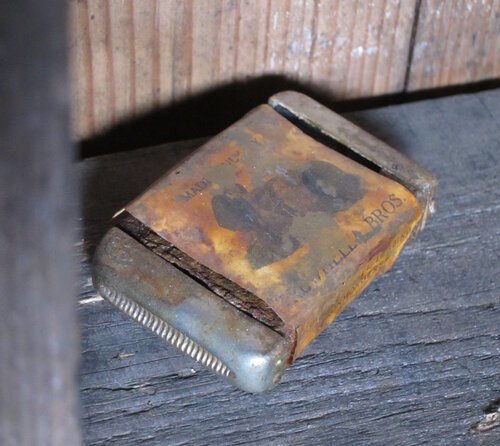
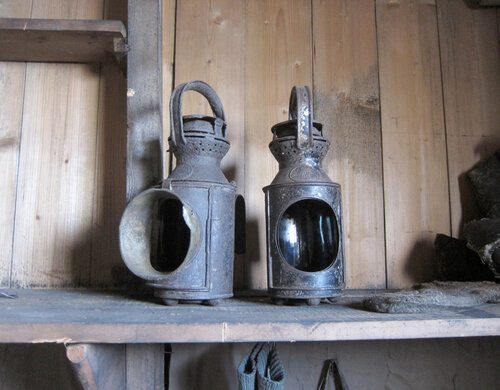

The thing that really surprised me about Scott’s cubicle was how far the desk was from the bed, as the famous photo makes it look like a compressed space. Looking back at my photos against that one, I see now that he is not writing at the central desk that is there now, but instead at a smaller one that collapsed against the wall, and he’s sitting on his bed, not a chair. If you look closely at the first of my photos above, you can still see the triangular wooden support bracket still against the wall, though the table top is gone. So the large desk that is still there must be what was known as the chart table, and Scott’s collapsible desk was his writing desk. Learning new things all the time!
From Scott’s cubicle, you get a good view into one of the much less well=photographed parts of the hut, the nook that was shared by Lt. Evans and Dr. Wilson.
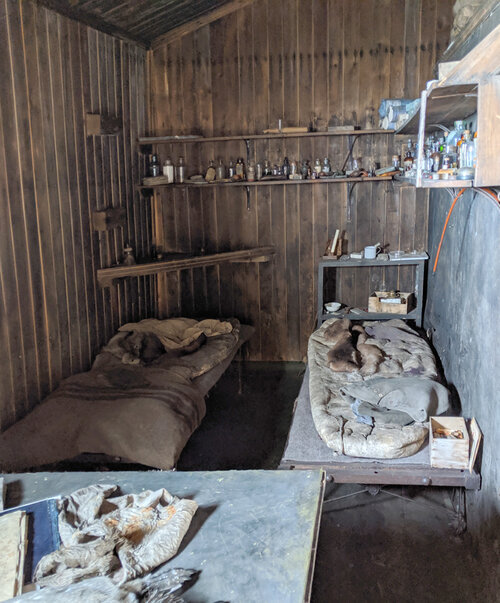
Having only ever seen one photo of this space, I guessed it was overlooked by photographers because it really wasn’t much to look at, but trying to photograph it myself I think it’s also because the light conditions are extremely awkward. The light from the window shines bright on the wall to the right and on the table in the foreground, but Teddy’s corner is in deep darkness. The human eye can compensate for this somewhat, but cameras want to use one exposure setting for the whole image, and it just doesn’t work! This was the best I got, with the nighttime setting on my phone and some help from Photoshop. It seems like a lot of work for a middling photo of an unimpressive space, but the whole reason I was there was to get into the corners that are mostly left out of the photographic record, and this was one of the most important ones.
The shelves around Wilson’s bunk are full of medicines and medical supplies – you can see piles of rolled-up gauze bandages in the upper right. Wilson wasn’t the chief medical officer on the expedition (that was Atkinson, whose bunk we saw in the Tenements) but he had qualified as a medical doctor and had been Junior Surgeon on the Discovery, so they are not misplaced.
On his bed is a rather comfy-looking sweater:

Oh all right, here’s a shot of Scott’s cubicle. See? Empty. But I hadn’t seen it from Wilson’s bunk before, and this gives you more of a sense of space.
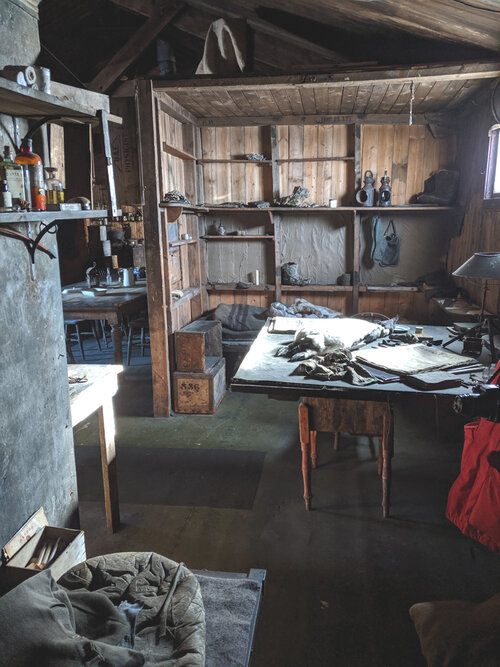
To the right is Ponting’s darkroom, where the picture at the top of this post was developed, and beyond that another of the largely unphotographed corners of the hut. But that is an adventure for next time!
#antarctica#cape evans#scott expedition#terra nova expedition#captain scott#robert falcon scott#bill wilson#edward adrian wilson#teddy evans#edward radcliffe garth russell evans#polar exploration#historic huts#cape evans hut#workspace
69 notes
·
View notes
Photo

Big Box of Valiant Book Two-
Harbinger Vol. 1: Omega Rising - Joshua Dysart (writer); Khari Evans with Matthew Clark, Lewis LaRosa, and Jim Muniz (art); Matt Ryan and Sean Parsons (inks); Ian Hannin with Moose Baumann, Jeremy Cox, and Chris Sotomayor (colors); Rob Steen (letters). Valiant Comics 2012.
This book isn’t as fun as X-O Manowar. Basically, if you’ve seen Stranger Things, or read Firestarter or Akira, you already know the deal.
Teenager Peter Stanchek is a powerful telekinetic (or “psiot”). Peter and his schizophrenic pal Joe have escaped from the nut hut and are living by their wits in abandoned apartments and vacant houses in the suburbs, trying to stay one step ahead of the authorities. Peter is picked up by the sinister (and most likely evil) Harada Global Conglomorates, where other psi-powered kids are being activated as “Harbingers,” basically the New Mutants but everybody’s Rachel Summers.
The more time Peter spends around his fellow Harbingers the more creeped out he gets by the program and its founder, powerful psiot (and billionaire) Toyo Harada. Peter learns that Harada has been performing painful medical procedures on teenagers to activate their psionic powers, often with deadly results. Peter briefly befriends fellow psiot Faith Herbert, who helps him escape, before discovering that his old pal Joe has been murdered by the company. Peter declares war on Harada, while Faith is just stoked to finally be a real superhero.
This story covers real familiar ground for any X-Men or Stephen King fans in the audience. Thankfully the creators avoid the Gen 13 route of making all the Harbingers instant superfriends; at the end of Book One only Faith and Peter are on the outside, while the other Harbingers are still under Harada’s employ (for the time being at least). Faith brings a lot of much-needed levity to the story, and I’d like to read more about Livewire in future volumes as well.
The art matches the story’s gritty, angsty tone. I was impressed with the attention to detail, especially in the grimy Pittsburgh crackhouses and suburban neighborhoods and Harada’s swanky penthouse. The characters are very grounded and realistic, for the most part the artists avoid idealized superhero physiques and crazy effects (there aren’t any dayglo psychedelic battles on the Astral Plane, for example), which makes the supernatural elements feel more shocking than they would in a different type of cape comic.
I didn’t love Harbinger but I’m definitely interested to see where it goes.
#valiant comics#harbinger#jim shooter#joshua dysart#faith herbert#lewis larosa#khari evans#ian hannin#telekenisis#stranger things#x-men
2 notes
·
View notes
Text
Thursday Day 14 One of Scott’s Huts and Shackleton’s Hut
We are now the southernmost ship in the world and will continue to be for at least the next week or so. The US supply ship to McMurdo Station has left for more northern parts leaving us all on our lonesome at the plughole of the planet. It may not sound like much, but for me, it is a thrilling and unique experience.
We are now cruising around and exploring Ross Island for a few days and have criss-crossed our own path several times to take advantage of better conditions and wildlife opportunities.
We sailed past Cape Bird and Cape Royds down to Cape Evans where we made a landfall and visited Scott’s last hut, from which he left for the South Pole and never returned. All the huts around the Ross Sea have been preserved in precisely the condition they were when the Heroic Age of Exploration came to an end – at least inside the huts. Some (usually minimal) remedial or protective reconstruction has been necessary on the structures themselves but inside, they are essentially as they were 100-plus years ago. In some cases, a bit of restoration has been unavoidable, but almost everything is exactly as it was when the explorers closed the doors behind themselves and set off on whatever final mission they were attempting. Food is still on the tables, the beds are unmade, unwashed clothing is hanging on makeshift pegs, stores are piled up inside and out, even huge slabs of 110-year-old blubber are stacked waiting to be converted into fuel that will never be needed. It is quite an eerie feeling to prowl around the huts expecting Scott, Shackleton or one of their crews to round the corner of a wall and challenge us for intruding on their privacy. The amount of gear they had is staggering. Most things had to last them at least a year, but the huts are much bigger and more substantial than I imagined and the range and physical quantity of stores and equipment is quite astonishing.
After lunch, we sailed back to Cape Royds and most of us trekked across country to Shackleton’s Hut. Heather decided not to go because the track was described as a bit steep in places, but it was really very steep and quite dangerous. We were all strung out over the kilometre and a half (seemed a lot further than that!!) and we had to climb up and over a very steep volcanic field with viciously sharp rocks to get to the hut. I got to within about 5 metres of the top and came across a guy in front of me (John) who had just taken a horrific fall. I don’t think he fell a long way, but he was unconscious face down with his face terribly lacerated. David Harrowfield, our famous historian, was with him and he sent me off running to get the doctor. It was in the very most dangerous place of the whole trek and I was scared that I was going to fall myself, but I was ultra-careful and managed to get over the crest but then there was no clear path to the hut where the doctor was. I ran as fast as I could (with a lot of pain from my injured chest), and almost got there when I was passed by a young Russian crewman who had found an easier route and reached the doctor before me. I was feeling pretty sick imagining that poor John was dead but he eventually came around and was stretchered back to the ship where the doctor worked on him for a few hours. He had to have lots of stitches and his whole face is horribly swollen and bandaged all over, but he seems to be OK. He stayed in his cabin for almost 2 days but came out this morning to rousing cheers from almost everyone onboard. Amazingly, by the end of the trip, he was almost back to normal with only one small dressing still on his face.
As an aside, John and his wife Connie are Americans with whom we had a strange connection. They had been on a cruise a year or so ago where they had met and maintained contact with Richard and Robert, a couple with whom we have maintained contact from our Arctic expeditions last year. When Richard heard that they were going to be on the same Antarctic expedition as us, he brokered an introduction and we chatted with them regularly during our trip.
Shackleton’s hut was surrounded by Adelies and they all looked pretty scungy as they were moulting and the air near the ground was thick with tiny feathers. We had to pick our way through the penguins to enter the hut (the boot-scrubbing process ahead of every entry is quiet elaborate and the restrictions on entry to preserve the huts are quite extreme (justifiably so!!) so there was always quite a bit of queuing before anyone got into any of the huts.
I took a much slower path back to the beach where the zodiacs shuttled us back to the ship. There were more Adelies on the beach – and about a dozen fat Weddell Seals – they look like giant slugs and perhaps even more so when they are galumphing back to the sea and their copious layers of blubber are rippling back and forth along their ballooning bodies.
I was really glad that Heather had elected to stay on board because the trek to and from the hut was really very treacherous and she would have struggled to make it there and back. (Not to say that I found it easy – it was very challenging to say the least: easily the most difficult of any of our landings.)
1 note
·
View note